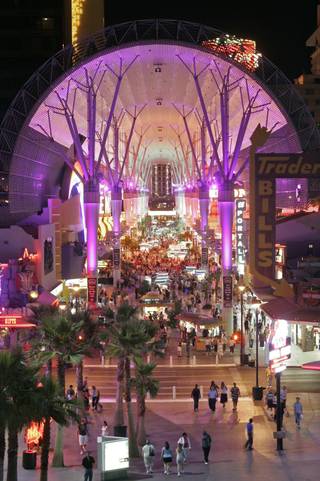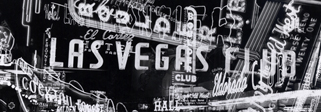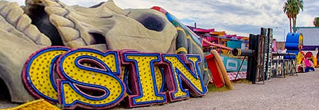Thursday, May 15, 2008 | 3 a.m.
Audio Clip
- Eugene Moehring, UNLV history department chairman, on the failure of Las Vegas to annex the Strip.
-
Audio Clip
- Moehring on how the I-15 favors the Strip.
-
Audio Clip
- Moehring on the location of the Convention Center.
-
Audio Clip
- Moehring on the evolution of downtown Las Vegas.
-
The canopy of lights that hangs over Fremont Street has a bit of a hypnotic, and fully intentional, effect on the people below. Walking through a crowd of hundreds who stand perfectly still, eyes cast upward on the synchronized 12.5 million LED lights and ears tuned to the 550,000-watt sound system is one of the city's most whimsical experiences.
Vintage hotels like The Plaza, Golden Nugget and Horseshoe still line the pedestrian mall, creating a dichotomy between the bright, high-tech light show and the old casinos with varied, and sometimes shady histories.
The Nevada legislature voted to lift the ban on gambling in 1931 and almost overnight, Fremont Street changed from a dusty railroad town's tree-lined main street into a two-block, neon-lit gambling mecca, branding itself "The Gateway to Boulder Dam."
With gambling and alcohol banned at the federal work camp, dam laborers poured into Las Vegas on days off to partake in the activities that made Sin City famous.
"Hundreds of thousands of people came to Vegas, discovered Vegas, and watched them build the dam," said Eugene Moehring of the UNLV History Department.
When Prohibition was repealed in 1933, Las Vegas, which had always rebuffed the law, barely noticed. The town and its main drag prospered until 1935 when work on the newly christened Hoover Dam was completed and its 5,000 workers and their weekly paychecks flowed out of Nevada as quickly as they flooded in.
Fremont Street stagnated for the next few years and remained a desolate weekend retreat for Los Angelenos and couples seeking quickie divorces. Tourists on their way to and from the dam would come in by train or car and spend a few dollars but tourism dried up each winter. The neon signs and clap board casinos that lined Fremont, despite having legal sanction, were unable to compete with the posh, gangster-run clubs operating in Los Angeles and other large cities. Town boosters tried a number of schemes and strategies to bring in tourists, but to many it seemed that the prosperity brought by the dam's construction could not be duplicated. The town was simply too isolated to draw in the business it once enjoyed.
The city that would turn risk into its primary industry would soon see fortune of its own.
Highway 91, now Las Vegas Boulevard, was paved in 1937 as part of the New Deal, creating a vital automobile link to Los Angeles.
When Los Angeles cracked down on illegal gambling dens in 1938, a new mob element started to immigrate into Las Vegas, bringing with it a national network of investment and clientele. U.S. involvement in World War II, already anticipated by 1941, brought in federal investment in the form of a magnesium processing factory and a gunnery school, employing a total of 25,000 people. The casinos and clubs along Fremont Street, linked heavily to organized crime, once again prospered.
"What really got us launched was World War II," said Moehring, "thats when the defense workers and the soldiers taught us a lesson; railroading is not going to be your big industry, gambling is."
The war ended in 1946, but federal money stayed and Fremont Street saw the rise of the El Cortez, purchased by Benjamin "Bugsy" Siegel in 1946, and Ted Binion's amalgamation of several older casinos, the Horseshoe.
Investment along Fremont continued right up through the 1950s and new casinos continued to pop up as atom bombs were detonated just 65 miles away. The casinos along Fremont St. and the nation, however, began to take notice of the new hotel-casinos along Highway 91, just outside the borders of the city's taxes, regulations and committees. The new establishments had plenty of parking, grassy fields, sparkling pools and hotel rooms. They offered guests more privacy and space than the tight blocks of Fremont Street.
The late 1950s became a turning point in the struggle for tourist dollars between the city of Las Vegas' Fremont Street and the newly christened Paradise City and Winchester (now townships) along the Strip. With the Convention Center, built within ideal proximity of the Strip instead of Fremont Street, the former main drag benefited but was soon eclipsed. Seeing that the economic tide was changing, Las Vegas tried twice to annex the Strip but was unable to secure approval from the County Commission or the residents who lived there. "The city of Las Vegas never annexes one inch south of Sahara Avenue. Sahara was the border in 1905 and it's where the border is today," said Moehring, "If you look at places like San Antonio, they annexed everything for miles around the original city; they really failed, Vegas really failed."
For many tourists visiting Las Vegas since the 1960s, the Strip was all they knew of Las Vegas and Fremont Street withered. The tourism gains that came with the new jet-ready McCarran Airport (1963) and Highway 15 would benefit the Strip far more than the few blocks of casinos downtown. Over the next few decades, an aura of crime and urban decay surrounded the downtown area as federal policies, investors and local residents began to favor the newer suburbs built further and further away from the city's center. Fremont Street stagnated until the late 1990s.
During the late 1970s through the 80s much of Las Vegas was locked in a holding pattern. Atlantic City in the East was starting to attract the revenue Las Vegas once enjoyed after it legalized gambling in 1976. The perception of mob involvement and crime in Las Vegas also kept many possible visitors away.
It wasn't until the Mirage resort was completed in 1989 that Wall Street was convinced that more expensive, corporate owned properties could work. Las Vegas began to see a reinvestment surge starting in the 1990s, led by corporations and more varied investors from outside of Las Vegas.
Most of this new investment went to the Strip. City officials and opportunity-seeking businessmen tried their hands at new ventures and projects to bring people back within city limits. Attractions such as the Fremont Street Experience with its canopy of lights (completed in December of 1995) and Neonopolis (2002) have brought more attention to Fremont Street. Overall revenues and tourism still pale in comparison to that of the Strip.
The implosions of many of the less expensive Strip hotels (and their cheaper room rates) and replacement with high-end resorts has translated into a much needed boost for downtown Las Vegas. Room occupancies have remained high and attracting tourists is no longer a problem.
Downtown Las Vegas experienced tremendous growth in real estate values during the 2002-2005 real-estate boom and a multitude of high-rise condo projects are under construction, following a national trend in reinvestment toward old downtown areas and boosted by the more ambitious condo projects undertaken along the Strip.
Fremont Street and the area surrounding it are among the few places in Las Vegas to have shorter blocks and a tighter street grid, one of the reasons that investors consistently chose the Strip for massive new casino development has conversely become a particularly attractive option for those seeking to enjoy (or develop) a more urban environment. With revitalization efforts underway on the eastern portion of Fremont Street and the Arts District just to the south, Fremont Street is likely to enjoy more prosperity in times to come.
For now the main attraction, aside from gambling, is the LED Canopy and pedestrian mall called the Fremont Street Experience which 25,000 people, on average, will visit each day. Two permanent stages have been installed to accommodate nightly performances. "Viva Vision," the canopy light show, plays on the hour after the sun goes down and shows last about 6 minutes. The Fremont Street Experience tries to embody a permanent party atmosphere all year round with free concerts, street performers and vendors selling alcohol, food and souvenirs. "It's free entertainment, seven nights a week, in a casual atmosphere, " said Fremont Street Experience LLC executive assistant Megan Conklin.
There has been some contention between the city and the American Civil Liberties Union as to whether the Fremont Street Experience area of Fremont Street is still a public space where people can engage in demonstrations and loiter indefinitely, with the most recent victory going to the ACLU. The area is officially designated as a city park but is partially owned by the neighboring casinos and administered by Fremont Street Experience LLC, which hires private security guards and books and regulates entertainment and retail. "We are mostly a marketing company, " said Conklin, "but we handle maintenance and plan all special events." According to Conklin, FSE LLC receives at least one event request each day and the most popular events are for New Year's Eve and the NFR Hodown. Many charity walks and parades start or end at the Fremont Street Experience as well.


 Explore Las Vegas’ past and present
Explore Las Vegas’ past and present Boomtown: The Story Behind Sin City
Boomtown: The Story Behind Sin City Neon Boneyard: A 360° look
Neon Boneyard: A 360° look Mob Ties: See the connections
Mob Ties: See the connections Implosions: Classic casinos crumble
Implosions: Classic casinos crumble